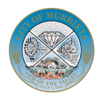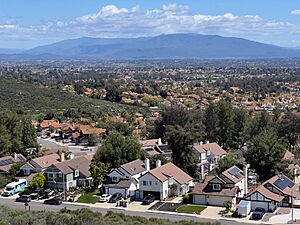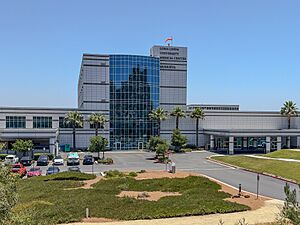Murrieta, California facts for kids
Quick facts for kids
Murrieta, California
|
|||
|---|---|---|---|
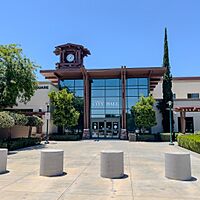
Murrieta City Hall
|
|||
|
|||
| Nickname(s):
Gem of the Valley
|
|||
| Motto(s):
"The Future of Southern California"
|
|||
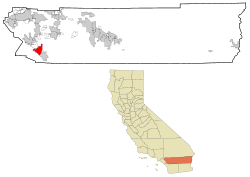
Location in Riverside County and the State of California
|
|||
| Country | |||
| State | |||
| County | |||
| Incorporated | July 1, 1991 | ||
| Named for | Juan Murrieta | ||
| Government | |||
| • Type | Council–manager | ||
| Area | |||
| • Total | 33.65 sq mi (87.15 km2) | ||
| • Land | 33.61 sq mi (87.06 km2) | ||
| • Water | 0.04 sq mi (0.09 km2) 0.11% | ||
| Elevation | 1,175 ft (334 m) | ||
| Population
(2020)
|
|||
| • Total | 110,949 | ||
| • Estimate
(2022)
|
113,783 | ||
| • Rank |
|
||
| • Density | 3,385.39/sq mi (1,306.95/km2) | ||
| Time zone | UTC−8 (Pacific) | ||
| • Summer (DST) | UTC−7 (PDT) | ||
| ZIP Codes |
92562–92564
|
||
| Area code | 951 | ||
| FIPS code | 06-50076 | ||
| GNIS feature IDs | 1667919, 2411199 | ||
Murrieta is a city located in the southwestern part of Riverside County, California, in the United States. In 2020, about 110,949 people lived here. Between 2000 and 2010, Murrieta grew very fast. It was one of the quickest-growing cities in California. Many people who live in Murrieta travel to other cities for work. It's often called a "bedroom community."
Murrieta is next to Temecula (south), Menifee and Wildomar (north), and French Valley (east). It is in the middle of the large Los Angeles-San Diego area. The city is named after Juan Murrieta, a rancher who helped start the town.
Contents
History of Murrieta
The Luiseño people were the first to live in the area where Murrieta is today. They had a village called Avaa7ax or 'Avaa'ax.
For a long time, Murrieta was not a very big place. In 1873, Juan Murrieta and others bought a large area of land. Juan Murrieta brought 7,000 sheep to the valley that same year. He used the grassy fields to feed his sheep.
Later, in 1882, Juan Murrieta allowed the California Southern Railroad to build tracks through his land. In 1884, a company bought land from Juan Murrieta and planned out a town. When a train station was built in 1887, it connected Murrieta to the main railroad lines. By 1890, about 800 people lived in Murrieta.
The town became popular for its hot springs, attracting many tourists. But when the trains stopped running in 1935, fewer tourists came. Murrieta then became a small country town.
A new highway, Interstate 15, was built in the early 1980s. This brought new growth to Murrieta. People started moving here from other parts of California. They came from San Diego, Orange, and Riverside Counties.
In 1990, people in Murrieta decided they wanted it to become an official city. The City of Murrieta was formed on July 1, 1991. By then, the population had grown from 2,200 in 1980 to 24,000. By 2010, Murrieta's population was 103,466. This made it the largest city in southwestern Riverside County at that time.
In 2014, Murrieta was in the news. People in the city protested against buses carrying people seeking a new home. These buses were on their way to a temporary facility the government planned to open in Murrieta.
Geography and Climate of Murrieta
Murrieta covers about 33.6 square miles (87.1 square kilometers). Most of this area is land. Murrieta Creek flows through the valley. Warm Springs Creek also runs through the city.
Murrieta's Climate
Murrieta has a Mediterranean climate. This means it has hot, dry summers and mild, wet winters. The city gets about 263 sunny days each year. It also has about 35 days with rain or other precipitation.
| Climate data for Murrieta, California | |||||||||||||
|---|---|---|---|---|---|---|---|---|---|---|---|---|---|
| Month | Jan | Feb | Mar | Apr | May | Jun | Jul | Aug | Sep | Oct | Nov | Dec | Year |
| Mean daily maximum °F (°C) | 67 (19) |
66 (19) |
71 (22) |
73 (23) |
78 (26) |
83 (28) |
91 (33) |
91 (33) |
89 (32) |
79 (26) |
74 (23) |
66 (19) |
77.4 (25.2) |
| Mean daily minimum °F (°C) | 41 (5) |
41 (5) |
45 (7) |
48 (9) |
52 (11) |
55 (13) |
62 (17) |
61 (16) |
57 (14) |
52 (11) |
46 (8) |
40 (4) |
50 (10) |
| Average precipitation inches (mm) | 3.22 (82) |
4.16 (106) |
.94 (24) |
.73 (19) |
.24 (6.1) |
.01 (0.25) |
.07 (1.8) |
.01 (0.25) |
.14 (3.6) |
1.32 (34) |
1.18 (30) |
3.54 (90) |
15.56 (395) |
| Source: weathercurrents.com | |||||||||||||
People of Murrieta: Demographics
| Historical population | |||
|---|---|---|---|
| Census | Pop. | %± | |
| 1990 | 1,628 | — | |
| 2000 | 44,282 | 2,620.0% | |
| 2010 | 103,466 | 133.7% | |
| 2020 | 110,949 | 7.2% | |
| 2022 (est.) | 113,783 | 10.0% | |
| U.S. Decennial Census | |||
Population in 2020
In 2020, Murrieta had a population of 110,949 people. Here's a look at the different groups of people living in the city:
| Race / Ethnicity (NH = Non-Hispanic) | Pop 2000 | Pop 2010 | Pop 2020 | % 2000 | % 2010 | % 2020 |
|---|---|---|---|---|---|---|
| White alone (NH) | 31,811 | 57,590 | 51,437 | 71.84% | 55.66% | 46.36% |
| Black or African American alone (NH) | 1,401 | 5,162 | 6,244 | 3.16% | 4.99% | 5.63% |
| Native American or Alaska Native alone (NH) | 190 | 389 | 487 | 0.43% | 0.38% | 0.44% |
| Asian alone (NH) | 1,718 | 9,304 | 11,158 | 3.88% | 8.99% | 10.06% |
| Pacific Islander alone (NH) | 92 | 332 | 440 | 0.21% | 0.32% | 0.40% |
| Other Race alone (NH) | 67 | 156 | 625 | 0.15% | 0.15% | 0.56% |
| Mixed race or Multiracial (NH) | 1,264 | 3,741 | 6,633 | 2.85% | 3.62% | 5.98% |
| Hispanic or Latino (any race) | 7,739 | 26,792 | 33,925 | 17.48% | 25.89% | 30.58% |
| Total | 44,282 | 103,466 | 110,949 | 100.00% | 100.00% | 100.00% |
Population in 2010
In 2010, Murrieta had 103,466 people. Most people (99.6%) lived in homes. About 30.4% of the population was under 18 years old. The average age was 33.4 years. For every 100 females, there were about 95 males.
There were 32,749 households. About 48.4% of these homes had children under 18. Most homes (62.8%) were married couples. The average household had 3.15 people. About 70.6% of homes were owned by the people living in them.
Population in 2000
In 2000, Murrieta had 44,282 people. The average household size was 3.1 people. About 33.7% of the people were under 18. The median age was 34 years. For every 100 females, there were about 96 males.
The average income for a household in 2007 was $78,883. For a family, it was $90,930. About 4.3% of the people in Murrieta lived below the poverty line.
Economy and Jobs in Murrieta
Murrieta has many businesses that provide jobs for its residents.
Top Employers in Murrieta
Here are some of the biggest employers in Murrieta as of 2023:
| # | Employer | # of Employees |
|---|---|---|
| 1 | Murrieta Valley Unified School District | 2,518 |
| 2 | Rancho Springs Medical Center | 1,550 |
| 3 | Loma Linda University Medical Center | 1,158 |
| 4 | County of Riverside | 907 |
| 5 | City of Murrieta | 432 |
| 6 | Target | 410 |
| 7 | Oak Grove Center | 329 |
| 8 | The Springs Health & Rehabilitation Center | 315 |
| 9 | Walmart | 304 |
| 10 | Encompass Health Rehabilitation Hospital | 194 |
Arts and Culture
The Town Square is a central spot in Murrieta. It has the Murrieta Police Department and the Murrieta Public Library. You can also find City Hall and a senior center there. There is also a special memorial for veterans.
Parks and Recreation
Murrieta has more than 52 parks! This includes a community swimming pool and a skate park. There are also three sports parks and two dog parks. You can find two disc golf courses and an equestrian park for horses. Many natural areas are also available for outdoor fun.
There are two golf courses in Murrieta. Bear Creek Golf and Country Club was designed by Jack Nicklaus. Even Presidents Gerald Ford and Ronald Reagan have played there. The Golf Club at Rancho California was designed by Robert Trent Jones, Sr.. Murrieta also has a Mulligan Family Fun Center. This is an amusement park known for its miniature golf.
Education in Murrieta
Most students in Murrieta go to schools in the Murrieta Valley Unified School District (MVUSD). Some parts of the city are served by the Menifee Union School District and the Perris Union High School District.
The Murrieta school district has:
- Eleven elementary schools (Kindergarten to 5th grade)
- Four middle schools (6th to 8th grade)
- Three high schools (9th to 12th grade): Murrieta Valley High School, Vista Murrieta High School, and Murrieta Mesa High School
- One alternative high school (Creekside High School)
- One independent study school
Calvary Chapel Bible College used to be at the Murrieta Hot Springs Resort. It operated there from 1994 until 2022. Mt. San Jacinto College is the closest community college. The University of California, Riverside (UCR) is the nearest public university. Murrieta also has learning centers for University of Phoenix and Azusa Pacific University.
Media
Channel 27 is a television station that serves the southwest Riverside County area. It broadcasts from a hilltop in Murrieta.
Infrastructure and Transportation
Transportation in Murrieta
Murrieta is served by two main Interstate highways. I-15 runs through the west side of the city. I-215 runs through the east side. Historic U.S. Route 395 also goes through downtown Murrieta. State Route 79 forms much of the city's eastern border.
The Riverside Transit Agency (RTA) provides bus services in Murrieta. The French Valley Airport is just east of the city. It is used for general aviation.
There are plans for a high-speed rail station in Murrieta. This station would be near the I-15 and I-215 freeway interchange. It is expected to serve many daily riders.
Hospitals in Murrieta
Murrieta has two hospitals:
- Loma Linda University Medical Center
- Rancho Springs Medical Center
Notable People from Murrieta
Many well-known people have lived in or are from Murrieta:
- Ambyr Childers, actress
- Charlotte Rose Craig, Taekwondo Olympic Medalist
- Lindsay Davenport, professional tennis player and Olympic gold medalist
- Meghan Dizon, professional pickleball player
- Rickie Fowler, professional golfer
- Tyler Glenn and Christopher Allen of Neon Trees (band)
- Javelin Guidry, professional football player
- Ben Jackson, professional Major League Gaming player
- Floyd Landis, cyclist
- Ryan Navarro, American football player
- Inbee Park, professional golfer
- Tom Pernice Jr., professional golfer
- Olivia Rodrigo, singer-songwriter and actress
- Kelly Seyarto, politician and former mayor of Murrieta
- Tyler Wade, Major League Baseball player
- Tyree Washington, track athlete
- Patrick Wisdom, Major League Baseball player
See also
 In Spanish: Murrieta (California) para niños
In Spanish: Murrieta (California) para niños



